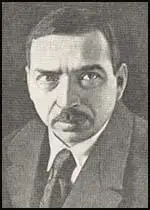Mikhail Tomsky

Mikhail Tomsky, the son of a factory worker, was born in St. Petersburg on 31st October, 1880. After a brief formal education Tomsky found work at the Theodor Kibbel factory and at the age of fourteen moved to the Smirnov Engineering factory.
Tomsky became involved in the struggle to form trade unions and this resulted in him losing his job at the Smirnov Engineering factory. In 1903 he became a socialist and the following year joined the Social Democratic Labour Party.
After being blacklisted in St Petersburg for his union activities he moved to Revel. During the 1905 Revolution Tomsky helped establish the Revel Soviet of Workers' Deputies. Following the publication of the October Manifesto, Tomsky helped form the Revel Union of Metal Workers. However, Nicholas II soon changed his mind about trade union reform and Tomsky was arrested and deported to Siberia.
Tomsky soon escaped and after returning to St Petersburg continued with his trade union activities. This included becoming prtesident of the Union of Engravers and Chromolithographers. He also wrote articles for Proletary and Vperyod.
A Bolshevik, Tomsky was once again arrested and imprisoned in May, 1908. On his release in 1909 he lived for a while in France before returning to Russia where he organized the publication of Rabocheye Znamya in Moscow. Tomsky was arrested in December, 1909 and was kept in custody for two years before he was brought to court and sentenced to five years hard labour.
After the abdication of Nicholas II Tomsky was freed by the Provisional Government and he returned to Moscow where he took part in the October Revolution.
Tomsky took part in all the major conferences on trade unions in Russia and in 1920 became General Secretary of the Red International of the Trade Unions. He was also elected to the Central Committee of the Communist Party and the Politburo in 1922.
A close ally of Joseph Stalin, Tomsky was on the right-wing of the party and was extremely hostile to the group led by Leon Trotsky. In 1926 he joined with Stalin, Nikolay Bukharin and Alexei Rykov to begin the purge of the left from the party.
After the removal of the left Stalin turned on the right of the party. As head of the trade union movement, Tomsky posed a threat to Stalin's power. In April, 1929, he was forced to resign from his trade union posts. He remained a member of the Central Committee and in 1934 became director of the State Publishing House.
After being informed he was about to be arrested by the NKVD, Mikhail Tomsky committed suicide on 23rd August, 1936.
